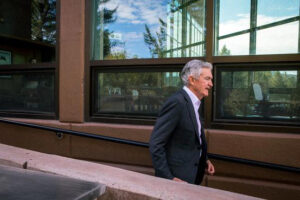SEPTEMBER 20, 2023

Federal Reserve officials are set to hold interest rates steady at their meeting Wednesday while debating what it would take for them to lift borrowing costs again this year.
Their anticipated decision would mark the second time in six policy meetings this year that the Fed hasn’t raised rates, slowing the pace of increases to allow more time to study their effects on the economy and inflation.
The Fed rate-setting meeting began at 9 a.m. Eastern Time as scheduled, the central bank said. The Fed will announce its decision and release policy makers’ quarterly economic projections at 2 p.m. Fed Chair Jerome Powell will answer questions from reporters at 2:30 p.m. Here’s what to watch for:
The Fed has signaled it will hold rates steady and make no substantive changes to its postmeeting policy statement. The public’s attention will focus heavily on officials’ quarterly interest-rate projections displayed in the so-called “dot plot.”
The median projection is likely to show officials expect to raise the Fed’s benchmark federal-funds rate at least once more this year, from the current range of between 5.25% and 5.5%. That would match their June projections when 12 officials expected that outcome and six anticipated no further increases. It is possible that this time fewer officials will pencil in that added hike.
From a communications standpoint, it would be easier for officials to project one more increase and then opt against it than to signal no more increases and then hike again, said William English, a former senior Fed economist who is a professor at Yale School of Management. “I’d be inclined to leave it in unless you really think it’s not going to be necessary,” he said.
Another major focus on the dots: Do officials expect to need somewhat higher rates in 2024 than they did in June? Last time, the median projection showed they anticipated reducing rates next year by 1 percentage point, to around 4.6%. If officials now think inflation will slow somewhat less, they might project fewer rate cuts next year.
Powell’s news conference provides an opportunity to explain how officials’ outlook has changed since their last meeting in July, which could offer important clues about how much conviction officials share on a final rate rise.
Until recently, officials were more concerned about the risk of raising rates too little and allowing high inflation to grow entrenched. But some are now focusing on the danger of raising rates too much and causing an unnecessarily severe slowdown, setting up a debate this week over whether to hike again this year.
This shift is driven by signs of easing inflation and a less overheated labor market. In addition, the unusually rapid rate increases implemented over the past 1½ years are expected to crimp economic demand in the coming months.
Fed officials are likely to be “cautiously optimistic, with an emphasis on cautiously,” said Antúlio Bomfim, a former adviser to Powell who is now at Northern Trust Asset Management. “They’ve seen enough to take some more time, but I don’t think [the data] has been enough to meaningfully tilt the consensus toward, ‘Hey, we are done.’”
If Powell wants to stay in the middle he could strike his best impersonation of the late Kobe Bryant. In 2009, with his Los Angeles Lakers jumping to a 2-0 advantage in the best-of-seven NBA Finals, Bryant frowned when a reporter asked him why he didn’t seem more excited. “Job’s not finished,” Bryant shot back.
Like those Lakers, who went on to win the series, Fed officials have reason to feel better about the economy than they did in June or July. Market-determined borrowing rates have climbed since late July, which should help slow economic activity. But officials have been in a similar position before with inflation apparently declining, only to see price pressures resurge. That could make them cautious about declaring victory.
Officials’ new economic projections could further illustrate why it is likely too soon for Powell either to signal that the Fed is done raising interest rates or to firm up plans for another increase.
Economic growth has picked up recently, defying officials’ projections for a slowdown. At the same time, inflation has declined somewhat faster than they anticipated in June.
Officials are now likely to project stronger economic growth and lower inflation than they did in June.
Wall Street forecasters estimated that core consumer prices, which exclude volatile food and energy prices, rose just 0.1% in August, according to the Fed’s preferred gauge. That would lower the 12-month core inflation rate to 3.8%—below the 3.9% year-end projection officials had in June.
Officials are likely to wrestle with two questions here: First, would stronger consumer spending or business investment in the coming months raise enough concern about inflation to warrant higher rates? Second, could officials signal an end to rate increases this fall if core inflation remains mild?
Between the 2008 financial crisis and the start of the pandemic in 2020, Fed officials and economists had concluded the neutral rate of interest—the level that balances supply and demand when the economy is operating at full strength—had declined sharply. That, together with weak growth following the crisis, ushered in a period of historically low-interest rates.
In recent economic projections, a few officials appear to have raised their expectations for the long-term neutral fed-funds rate. Most officials estimate this rate to be around 2.5% when inflation is 2%. If more officials lift their projections for the neutral rate, that would suggest that interest rates on mortgages, credit cards, and business loans are likely to settle at higher levels even if inflation falls lower.
Officials will also provide their economic forecasts for 2026 for the first time this week. Those projections offer another way to show that rates might not return to the low levels that prevailed before the pandemic.










































































































